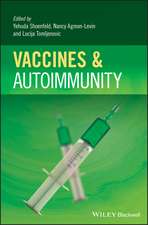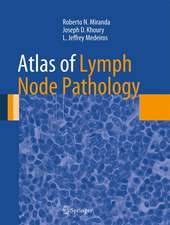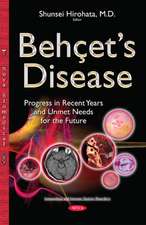Chemotactic Cytokines: Biology of the Inflammatory Peptide Supergene Family: Advances in Experimental Medicine and Biology, cartea 305
Editat de J. Westwick, I. J. D. Lindley, S.L. Kunkelen Limba Engleză Paperback – 6 apr 2012
Din seria Advances in Experimental Medicine and Biology
- 9%
 Preț: 719.60 lei
Preț: 719.60 lei - 20%
 Preț: 691.93 lei
Preț: 691.93 lei - 5%
 Preț: 717.00 lei
Preț: 717.00 lei - 5%
 Preț: 716.28 lei
Preț: 716.28 lei - 5%
 Preț: 717.20 lei
Preț: 717.20 lei - 15%
 Preț: 640.24 lei
Preț: 640.24 lei - 5%
 Preț: 1113.83 lei
Preț: 1113.83 lei - 5%
 Preț: 715.71 lei
Preț: 715.71 lei - 5%
 Preț: 820.43 lei
Preț: 820.43 lei - 15%
 Preț: 641.38 lei
Preț: 641.38 lei - 5%
 Preț: 716.28 lei
Preț: 716.28 lei - 5%
 Preț: 523.99 lei
Preț: 523.99 lei - 5%
 Preț: 1031.00 lei
Preț: 1031.00 lei - 5%
 Preț: 717.00 lei
Preț: 717.00 lei - 5%
 Preț: 715.35 lei
Preț: 715.35 lei - 20%
 Preț: 1161.71 lei
Preț: 1161.71 lei - 5%
 Preț: 1170.51 lei
Preț: 1170.51 lei - 18%
 Preț: 1119.87 lei
Preț: 1119.87 lei - 5%
 Preț: 1288.48 lei
Preț: 1288.48 lei - 5%
 Preț: 1164.67 lei
Preț: 1164.67 lei - 5%
 Preț: 1101.73 lei
Preț: 1101.73 lei - 18%
 Preț: 1123.67 lei
Preț: 1123.67 lei - 5%
 Preț: 1435.64 lei
Preț: 1435.64 lei - 20%
 Preț: 1044.10 lei
Preț: 1044.10 lei - 18%
 Preț: 946.39 lei
Preț: 946.39 lei - 5%
 Preț: 292.57 lei
Preț: 292.57 lei - 18%
 Preț: 957.62 lei
Preț: 957.62 lei - 18%
 Preț: 1235.76 lei
Preț: 1235.76 lei - 5%
 Preț: 1231.55 lei
Preț: 1231.55 lei - 5%
 Preț: 1292.30 lei
Preț: 1292.30 lei - 5%
 Preț: 1102.10 lei
Preț: 1102.10 lei - 18%
 Preț: 1132.81 lei
Preț: 1132.81 lei - 5%
 Preț: 1165.19 lei
Preț: 1165.19 lei - 5%
 Preț: 1418.48 lei
Preț: 1418.48 lei - 5%
 Preț: 1305.63 lei
Preț: 1305.63 lei - 18%
 Preț: 1417.72 lei
Preț: 1417.72 lei - 18%
 Preț: 1412.99 lei
Preț: 1412.99 lei - 24%
 Preț: 806.16 lei
Preț: 806.16 lei - 18%
 Preț: 1243.29 lei
Preț: 1243.29 lei - 5%
 Preț: 1429.44 lei
Preț: 1429.44 lei - 5%
 Preț: 1618.70 lei
Preț: 1618.70 lei - 5%
 Preț: 1305.12 lei
Preț: 1305.12 lei - 18%
 Preț: 1124.92 lei
Preț: 1124.92 lei - 5%
 Preț: 1097.54 lei
Preț: 1097.54 lei - 15%
 Preț: 649.87 lei
Preț: 649.87 lei - 5%
 Preț: 1097.54 lei
Preț: 1097.54 lei - 18%
 Preț: 945.79 lei
Preț: 945.79 lei - 5%
 Preț: 1123.16 lei
Preț: 1123.16 lei
Preț: 366.56 lei
Preț vechi: 385.84 lei
-5% Nou
Puncte Express: 550
Preț estimativ în valută:
70.15€ • 76.17$ • 58.93£
70.15€ • 76.17$ • 58.93£
Carte tipărită la comandă
Livrare economică 22 aprilie-06 mai
Preluare comenzi: 021 569.72.76
Specificații
ISBN-13: 9781468460117
ISBN-10: 1468460110
Pagini: 204
Ilustrații: 180 p.
Dimensiuni: 178 x 254 x 11 mm
Greutate: 0.36 kg
Ediția:Softcover reprint of the original 1st ed. 1991
Editura: Springer Us
Colecția Springer
Seria Advances in Experimental Medicine and Biology
Locul publicării:New York, NY, United States
ISBN-10: 1468460110
Pagini: 204
Ilustrații: 180 p.
Dimensiuni: 178 x 254 x 11 mm
Greutate: 0.36 kg
Ediția:Softcover reprint of the original 1st ed. 1991
Editura: Springer Us
Colecția Springer
Seria Advances in Experimental Medicine and Biology
Locul publicării:New York, NY, United States
Public țintă
ResearchCuprins
Granulocyte and Monocyte Chemotactic Factors: Stimuli and Producer Cells.- Activation of Human Neutrophils by NAP-1 and Other Chemotactic Agonists.- Induction and Regulation of Interleukin-8 Gene Expression.- Regulation of Human Interleukin-8 Gene Expression and Binding of Several Other Members of the Intercrine Family to Receptors for Interleukin-8.- Formation and Biological Properties of Neutrophil Activating Peptide 2 (NAP-2).- Human Monocyte Chemoattractant Protein-1 (MCP-1).- Biological Aspects of Monocyte Chemoattractant Protein-1 (MCP-1).- Stimulus Specific Induction of Monocyte Chemotactic Protein-1 (MCP-1) Gene Expression.- GRO: A Novel Chemotactic Cytokine.- PDGF and the Small Inducible Gene (SIG) Family: Roles in the Inflammatory Response.- Human Neutrophil Granule Cationic Protein CAP37 is a Specific Macrophage Chemotaxin that Shares Homology with Inflammatory Proteinases.- Biochemical and Biological Characterization of NAP-1/IL-8-related Cytokines in Lesional Psoriatic Scale.- Chemotactic Cytokines in Inflammatory Skin Disease.- Interleukin-8 — A Mediator of Inflammatory Lung Disease?.- Some Aspects of NAP-1 Pathophysiology: Lung Damage Caused by a Blood-borne Cytokine.- Human Mesangial Cell-derived Interleukin 8 and Interleukin 6: Modulation by an Interleukin 1 Receptor Antagonist.- NAP-1/IL-8 in Rheumatoid Arthritis.- Abstracts.- Cloning of CAP37, a Monocyte-specific Chemotactic Factor Released from Azurophilic Granules of PMN Leukocytes.- Three Human Homologs of Murine Macrophage Inflammatory Protein-1 (MIP-1).- Synthesis of LD78 Protein and its Binding to Myelomonocytic Leukemia Cell Lines.- Cloning and Characterization of cDNAs for Murine MIP-2 and Human MIP-2 Homologs.- ACT-2 Genomic Structure, Chromosomal Localization and Identification of ACT-2Receptors.- Biological Properties of the RANTES/SIS Cytokine Family.- Endothelial and Leukocyte Forms of Interleukin-8: Conversion by Thrombin and Interaction with Neutrophils.- Interleukin 8 Acts on Monocytes to Increase Their Attachment to Cultured Endothelium and Enhance Their Expression of Surface Adhesion Molecules.- Novel Neutrophil Chemoattractants Generated in Response to Zymosan In Vivo.- Different Pro-inflammatory Profiles of Macrophage Derived Interleukin-1, -8 and Tumour Necrosis Factor.- Interleukin-8 Enhances the Intracellular Killing of Mycobacterium fortuitum by Human Granulocytes.- Inhibitors of Protein Kinase C Activation Inhibit Interleukin-8-induced In Vitro Human Lymphocyte Migration.- Tumour Necrosis Factor (TNF?), the Inflammatory Component of HIV-related Lung Disease?.- Macrophage Heterogeneity and Tumour Necrosis Factor-? Release.- Conditions for the Demonstration of Tumour Necrosis Factor mRNA in Reactive and Neoplastic Cell Populations.- The Structure of Tumour Necrosis Factor.- IL-8 is a Potent Stimulator of Neutrophil Aggregation and Chemotaxis in Canine and Human Neutrophils.- Endogenous and Synthetic Inhibitors of the Production of Chemotactic Cytokines.- Induction of Haptotactic Migration of Melanoma Cells by Neutrophil Activating Protein/IL-8.- Chemotactic Cytokine Production by Vascular Cells.- In Vivo Inflammatory Activity of Neutrophil-activating Peptide-1.- IL-8 Produces Inflammatory Hyperalgesia via a Sympathetic Component.- Interleukin-4 Inhibits the Expression of Interleukin-8 from Stimulated Human Monocytes.- In Vivo Neutrophil Migration Induced by Tumor Necrosis Factor, Interferon-gamma and Interleukins 1 or 8.- Adherence to Plastic Induces IL-8 Expression from Mononuclear Phagocytes.- Monocyte Chemoattractants in StratumCorneum from Psoriatic Lesions.- Inhibition of IL-8 by Protein Kinase C (pkC) Inhibitors in Human Keratinocytes.- Monocyte Chemotaxis and Activating Factor Production by Cytokine-activated Human Epidermal Keratinocytes.- Differential Effects of Protein Kinase C Inhibitors on Interleukin 8 - induced Exocytosis in Human Neutrophils.- Interleukin 8 Stimulates an Increase in Cytosolic Free Calcium in HaCat Epidermal Cells and Neutrophils.- Interleukin 8 Priming of Human Neutrophils for an Enhanced Respiratory Burst: Role of Cytosolic Free Calcium.- Molecular Cloning and the Expression of Monocyte Chemotactic Protein, MCP-1, in Arterial Endothelium.- Modulation of IL-8 Generation in the Pre-monocytic Cell Line, U937.- Selective Inhibition of Cytokine Generation in Human Cells by an IL-1 Receptor Antagonist.- Invited Speakers.












